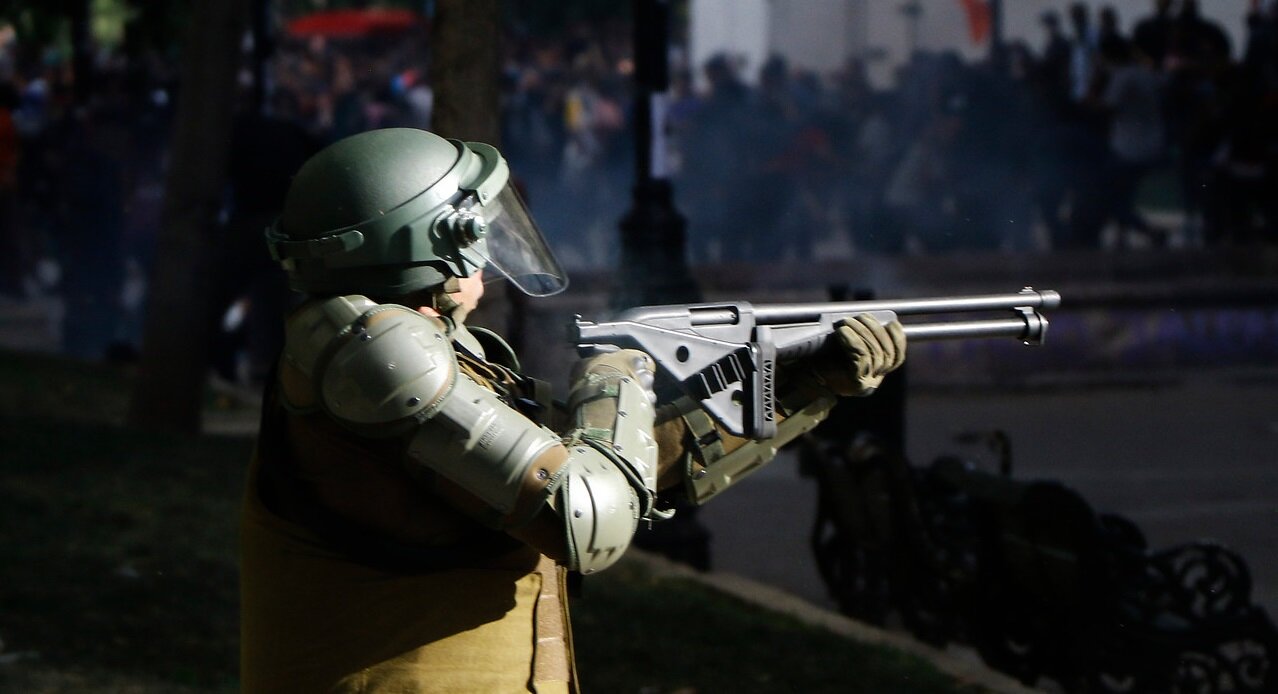Three days ago, Amnesty International released a harsh report on the police response to protests in Chile. Specifically, they accused the Carabineros (Chile’s national police force) of using violence—including shooting at the face—as tool in a deliberate strategy of intimidation meant to dissuade further protests. Apart from obviously backfiring, the allegations raise serious questions about the willingness and ability of the Carabineros to perform their duty of maintaining order without violating human rights. Perhaps unsurprisingly, the standing government immediately and forcefully rejected the report of Amnesty International, specifically due to the allegation that the Government has created “a policy of human rights violations with the intention of harming protestors and neutralizing the social movement.”
I want to take a slightly more scientific look at one aspect of the discussion that remains unclear: are the police deliberately, or just accidentally, shooting people in the face?
Here I demonstrate that it is almost certain in statistical terms that the Carabineros have been aiming for the head.
A strangely high number of people are being shot in the face by mysterious ammunition
To begin with, lots of demonstrators in Chile are presenting in emergency rooms with gunshot wounds to the face. Specifically, many organizations have taken note of the unusually high number of severe ocular injuries from less-than-lethal, supposedly “rubber” shot.
I have previously written about this issue from the ballistic perspective, showing that the “rubber” shot seems to be far more dangerous than previously recognized, and suggesting that the Carabineros seem to be remarkably ignorant of basic firearms principles. My analysis was motivated by a study from the Universidad de Chile, suggesting the density and composition of the “rubber” shot was inconsistent with pellets made out of unadultered (even vulcanized) rubber. These conclusions were supported by subsequent analyses by the Universidad Austral and the Universidad de Valparaíso, which validated the presence of lead, barium, and silica in the unusually dense pellets.
Several additional pieces of information have come to light regarding the problematic cartridges. First, the Carabineros published their technical spec sheet on the rounds, which—as I detailed in the Spanish-language update to my prior analysis—only demonstrated that the rounds were even more dangerous than what I had previously calculated using the Universidad de Chile’s data, and further called into question the organization’s firearms literacy. Second, a technical spec sheet from the manufacturer was published, which specifically indicated the cartridges were to be aimed solely at the legs of targets from distances not less than 20 meters. Third, an internal report from the Carabineros themselves on the ballistic effects of the rounds was released, which indicated that use at ranges of less than 25 meters could pierce the skin and result in serious injury, and use at even further ranges could cause severe ocular trauma. The report concluded by urging the weapons be used at a distance not less than 30 meters, and even then, only when aimed solely at the bottom third of a target.
In response, the Carabineros adopted a new strategy, suggesting that the amount of eye injuries was due to the imprecision inherent with the pellets. “Those who use [shotguns] do not control the trajectory of the pellets,” affirmed the chief of the police “Special Forces.” Another official somewhat notoriously compared the use of shotguns in crowd control to chemotherapy—“you kill good cells along with the bad cells.” The same official also stated “shotguns are not weapons designed for sharpshooting,” a statement that may have been repeated by the General-Director of the Carabineros, Mario Rozas.
Absent the discovery of written orders to shoot at the head, it’s next to impossible to literally prove the Carabineros are deliberately aiming at the face from distances that could blow up eyes (barring exceptional cases). What we can do, however, is evaluate the null hypothesis—can the number of severe ocular injuries be explained by sheer chance?
Shotguns 101
To think about the possibility that eye injuries could happen by chance, it is first necessary to know a bit about how shotguns work. Shotguns are long guns principally designed to fire plastic cartridges filled with pellets (known as shot). Pellets can be of different sizes and weights depending on their intended use, but in all cases the advantage pellets have over bullets is dispersion: each individual pellet follows its own trajectory leaving the barrel, resulting in a cloud of multiple projectiles that span a larger area than a single bullet.
As pellets travel through the air, they separate further, resulting in greater dispersion with greater range. Dispersion can be tinkered with by using a choke, a device that alters the dimensions of the shot cloud resulting in a narrower spread of shotgun pellets when they reach the target (the shot pattern). Barrel length has a small effect on muzzle velocity, and also indirectly affects accuracy due to the configuration of shotgun sights, but has no effect at all on the shot pattern. Dispersion helps when hunting small game, when the lesser kinetic energy of individual pellets is compensated by a greater likelihood of hitting the target. The pellets’ lower kinetic energy has led to the proliferation of shotguns in law enforcement, where lesser penetration means a lower likelihood of serious injury to bystanders.
Real-world dispersion is much less than that depicted in video games. At ~9 m distance (30 feet), the diameter of a circle circumscribing the shot pattern of a cylinder bore (no choke) shotgun is approximately 50 cm (19 in). Shot pattern diameter increases roughly linearly out to ~40 meters, where the diameter reaches ~150 cm. The high dispersion, as well as the decline in kinetic energy, makes shotguns progressively less-effective from this distance.
From Montana Hunter’s Ed
Although it is possible to predict general tendencies in shot pattern, a certain amount of uncertainty is inevitable when discussing the accuracy of shotguns. That is to say, if you point a shotgun at something, you are reasonably certain you will hit the target with at least some of the pellets within the shell, but there are some pellets that won’t necessarily behave like you’d want them to. Again, this is part and parcel of the shotgun experience, and is what separates shotguns from rifles or pistols. However, it introduces a certain degree of ambiguity when discussing potentially “accidental” hits to the face. It’s hard to claim that 170 people shot in the face with rifle bullets amount to a simple “oopsie,” but must be considered once we begin talking in terms of shotguns.
Simulating 5,000 body shots
I wish to statistically address whether or not it is plausible that the Carabineros have not aimed at the faces of protestors when firing shotguns filled with “rubber” pellets. Currently, 163 people have sustained serious eye injuries from projectiles, out of a total of 1,737 injured by projectiles of any kind, giving a bulk odds of about 1:10. That means roughly that 1 out of every 10 projectiles fired by police that have hit a person, have hit an eye.
Thinking only in terms of shotguns, if the eye injuries resulted solely from natural dispersion of pellets, then I should be able to replicate these odds in simulations that do not aim for the head. If I cannot replicate these odds, it indicates that the Carabineros must be aiming for the head.
Specifically, I answer the question: Are the current odds of eye shots to body shots significantly different from those generated by the natural dispersion of shotgun shot when aimed at center of mass?
To accomplish this, I wrote some code 1 that fires a 12-pellet shot at a guy’s chest from a specified distance. I then proceed to shoot him 5,000 times to see how many times he gets hit in the eyes 2 . The results look somewhat like this:
Test model results for one shot of 12 pellets at a distance of 20 meters. The inner ring corresponds to a circle of 50 cm diameter, and the outer ring corresponds to a circle of 100 cm diameter. The human figure is a standard human-sized target used by the International Practical Shooting Confederation. The eye boxes, which are not part of the IPSC standard target, correspond to the average dimensions of the orbit of the human eye, at a distance of ~29 cm from the center of mass defined by the IPSC. In this context it’s not really meaningful to generate odds from one shot.
I chose center of mass as the bullseye as there is no evidence at the time of writing of official orders from the Carabineros to shoot at any particular part of the body. Conventional firearms training teaches to aim for the center of mass (the chest, roughly sternum-height) so I choose this point as a reference for the tests that follow. (in any case, if the Carabineros were instructed to aim for the legs, it would make it even more difficult to explain the incidence of ocular injuries as accidental).
The full results are presented below.
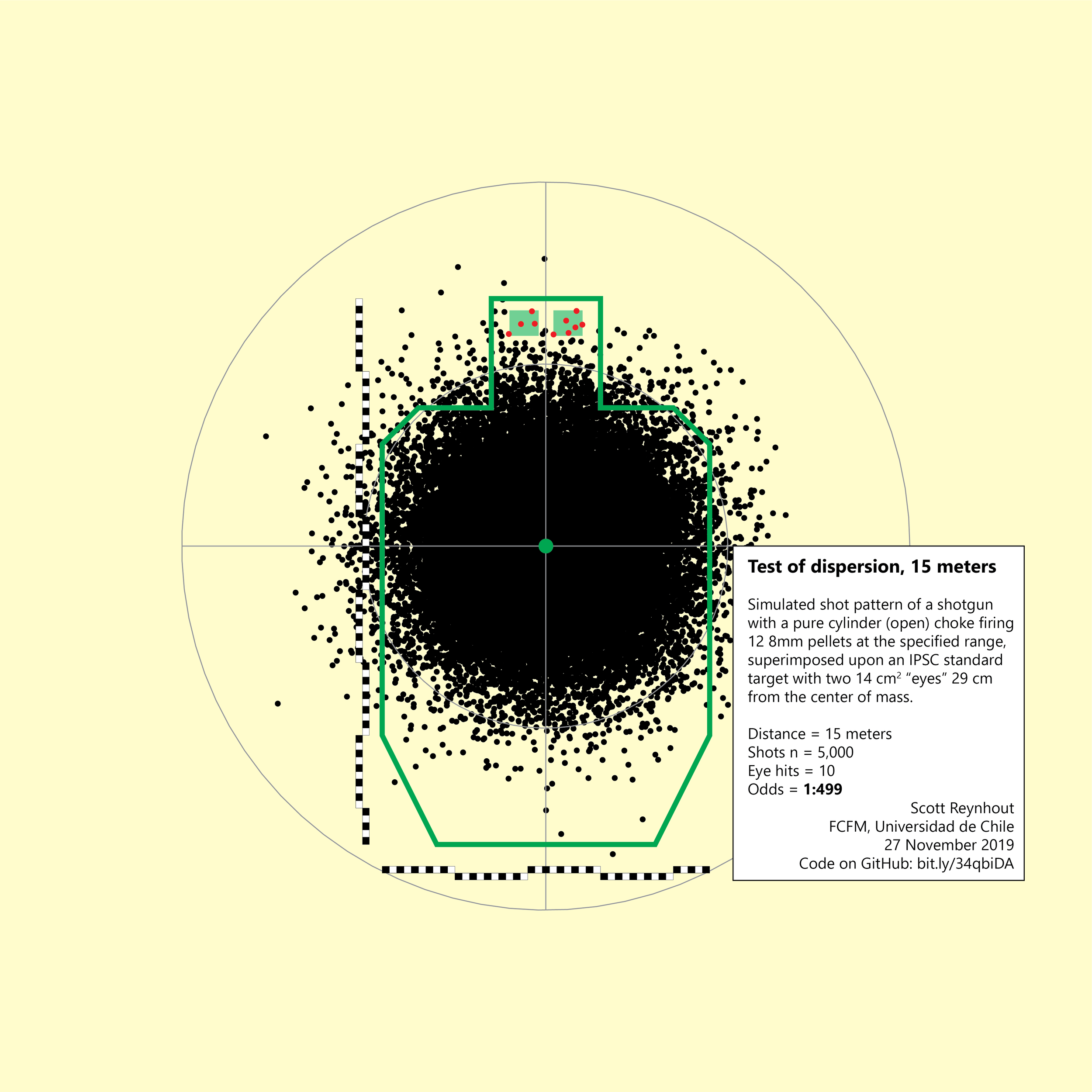

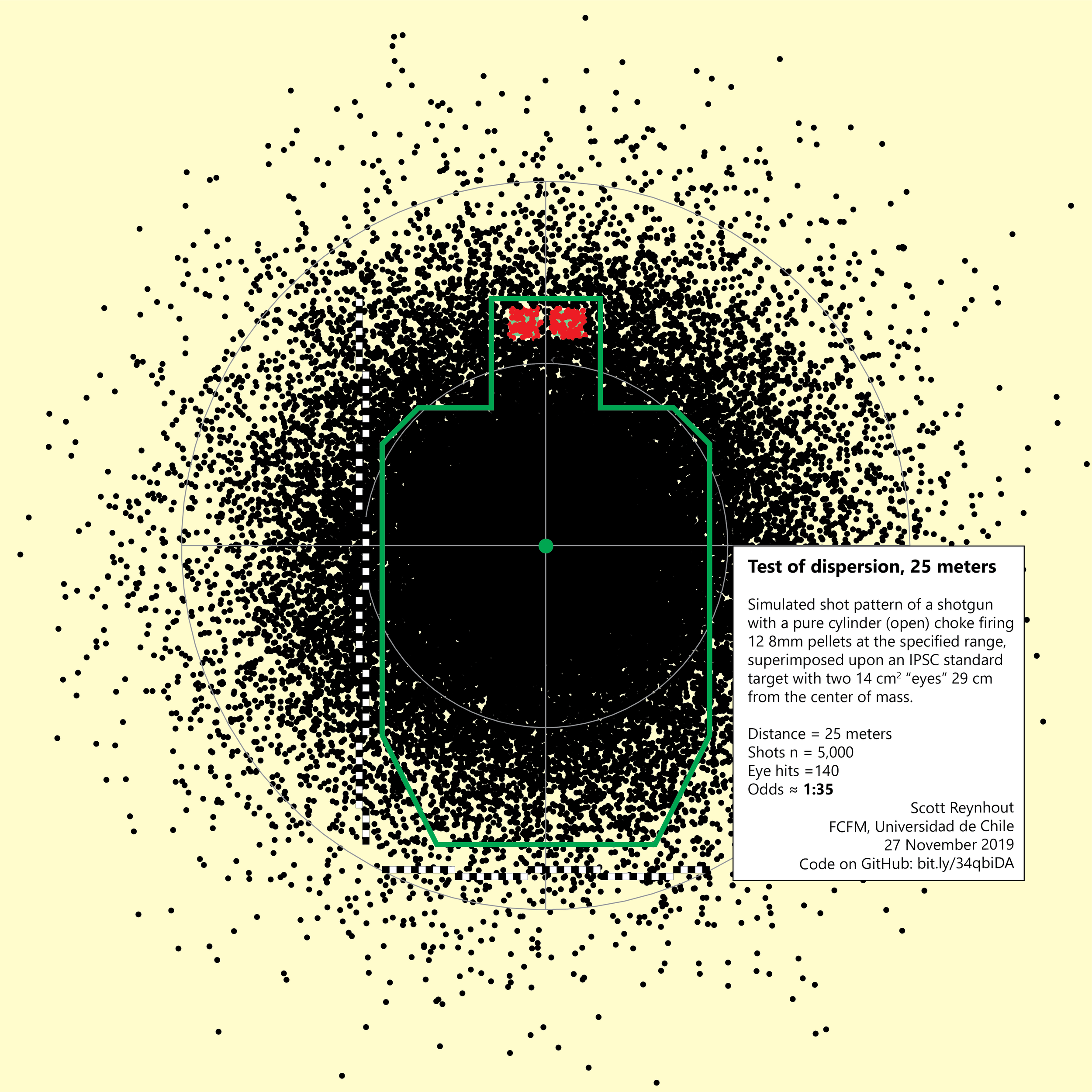
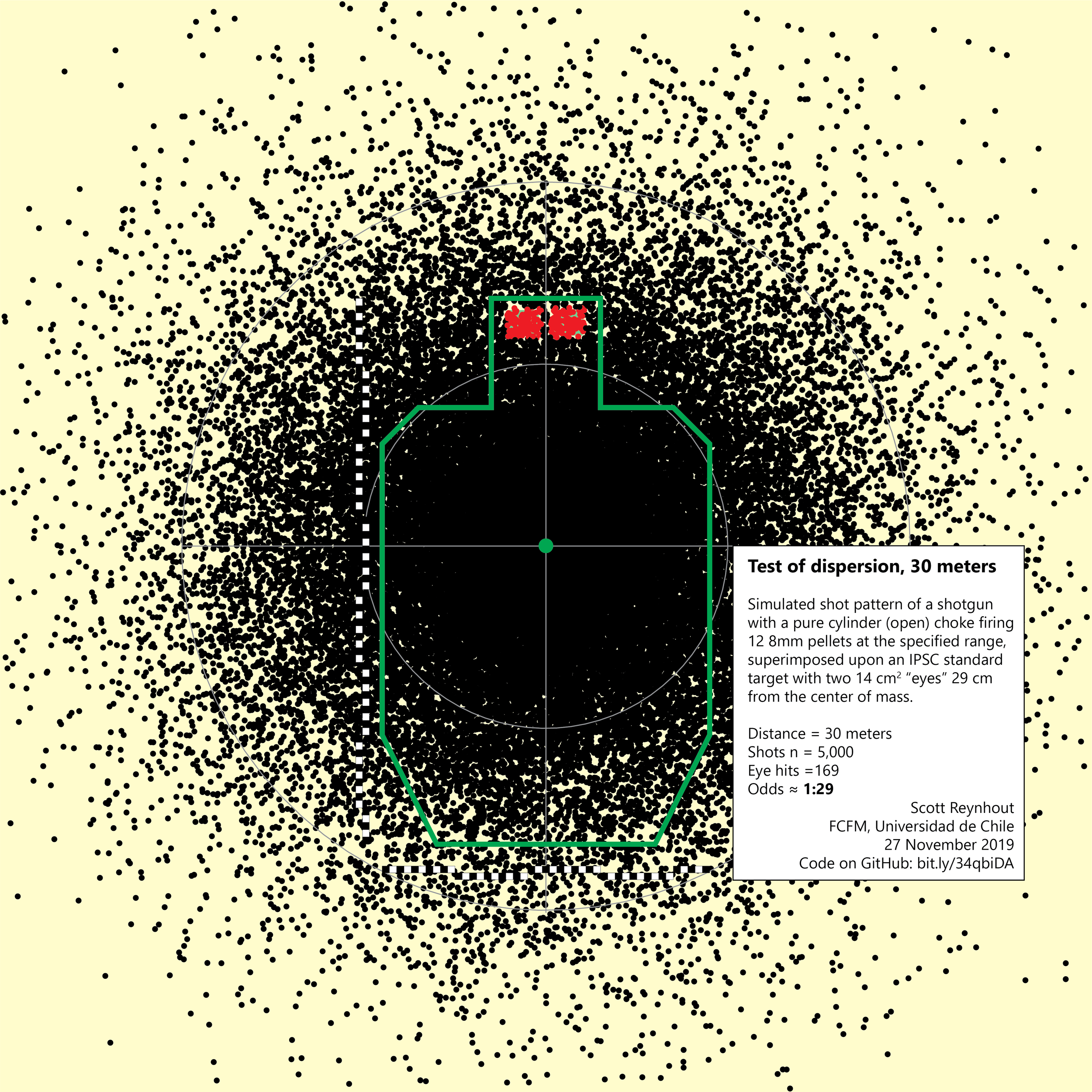
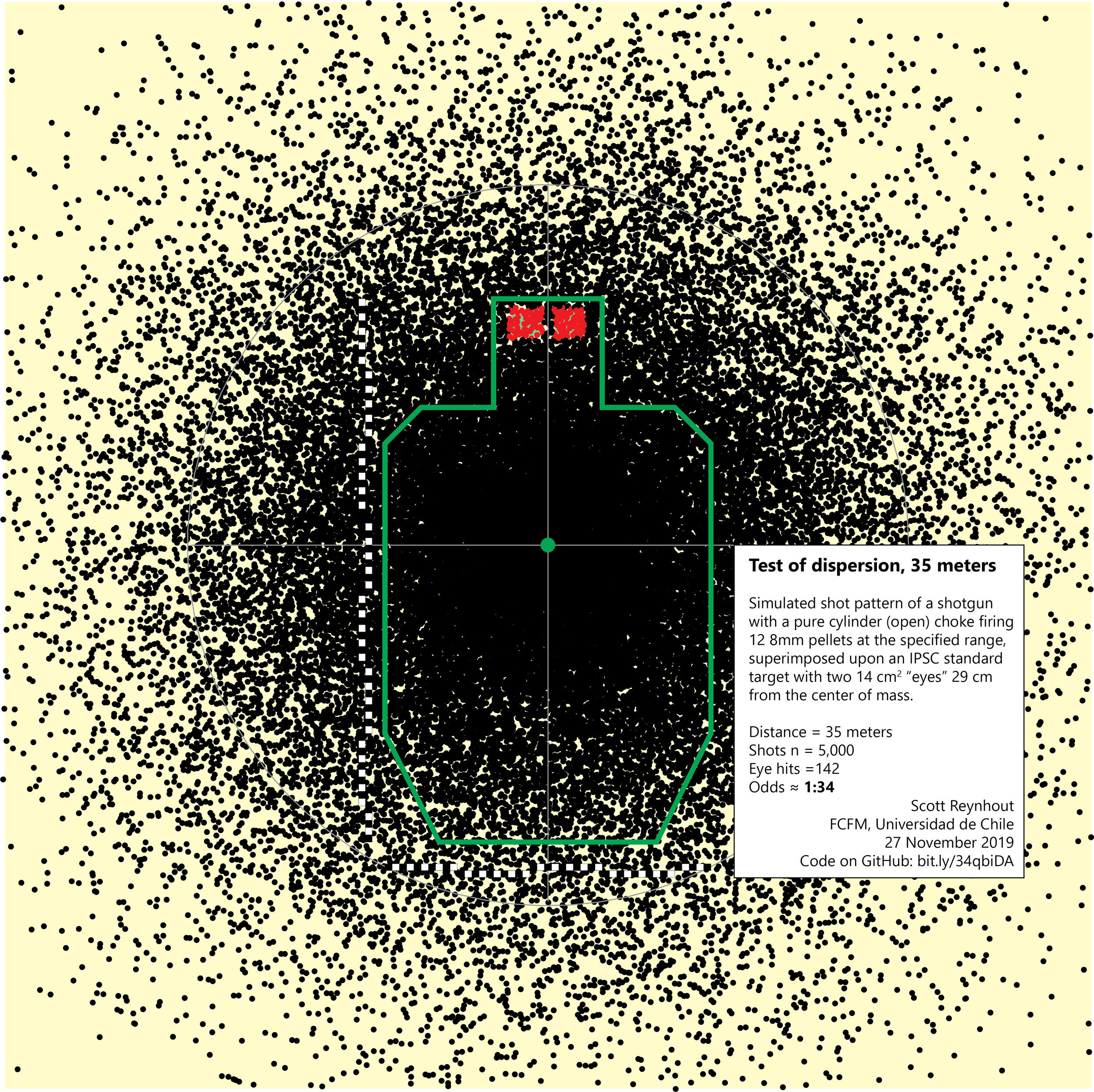
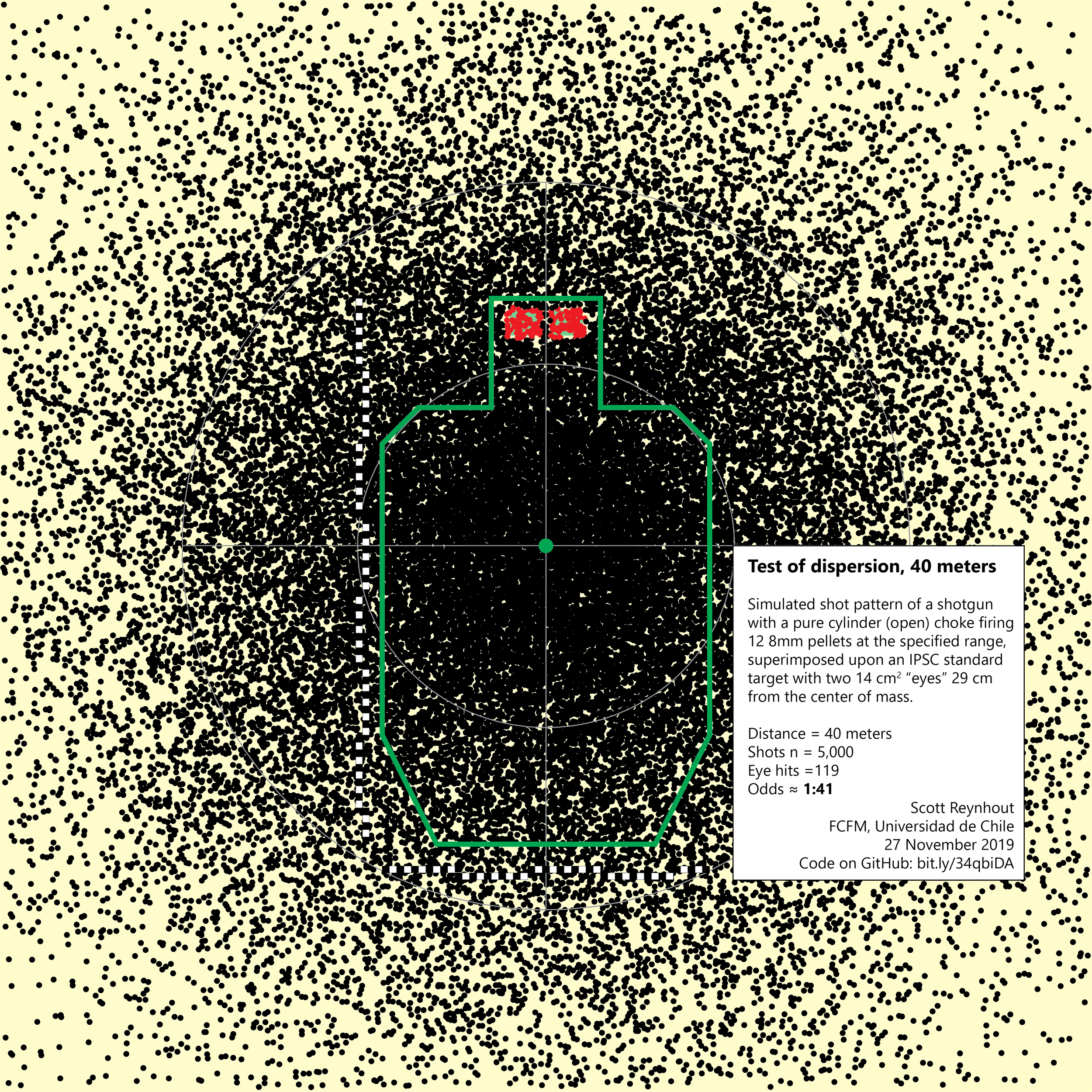
Odds for eye impacts by the shot tests range from 1:499 to 1:29, compared to odds of being shot in the eye in the street of 1:10. The most conservative odds ratio comparing the actual incidence of eye shots to the 30 meter shot test is 2.96 (95% confidence inveral 2.37-3.70), meaning you are at least three times more likely to be shot in the eye in the protests than in the control, where shots are always aimed towards center of mass.
I therefore conclude that it is almost statistically certain that the Carabineros have been aiming at the face.
“It isn’t possible to apply exactitude when nothing in shotguns is truly exact”
This is going to sound weird, but I am still not totally convinced that Carabineros are deliberately aiming at the face. Hear me out. The single biggest problem associated with simulating shotguns deployed in the field is that, same as in other disciplines, computer models cannot account for the human factor. In the modeling exercise above, I assume away this factor by assuming that the aim is perfect every shot. In the real world, I have serious doubts as to the Carabineros’ ability to keep these rounds on target.
To illustrate this, let’s consider the internal report (pdf) on the effects of the cartridges in question. The study consisted of a ballistic analysis of the “rubber” pellets’ ability to penetrate a roughly 0.9 cm thick, 50cm x 50cm plywood target. A single shot was fired at these targets at distances of 5, 10, 15, 20, 25, and 30 meters. It is immediately clear that the shooter had great difficulty consistently placing the shot pattern on target. At 10 meters the shooter failed to place all the pellets on the target, seemingly missing high. At 15 meters he pulled left, at 20 meters it’s impossible to tell what happened, by some miracle at 25 meters he turned into William Tell and placed 10/12 pellets on the plywood square, and at 30 meters (the recommended distance of use) only 2/12 pellets hit the intended target. This was all in the controlled environment of an indoor shooting range.
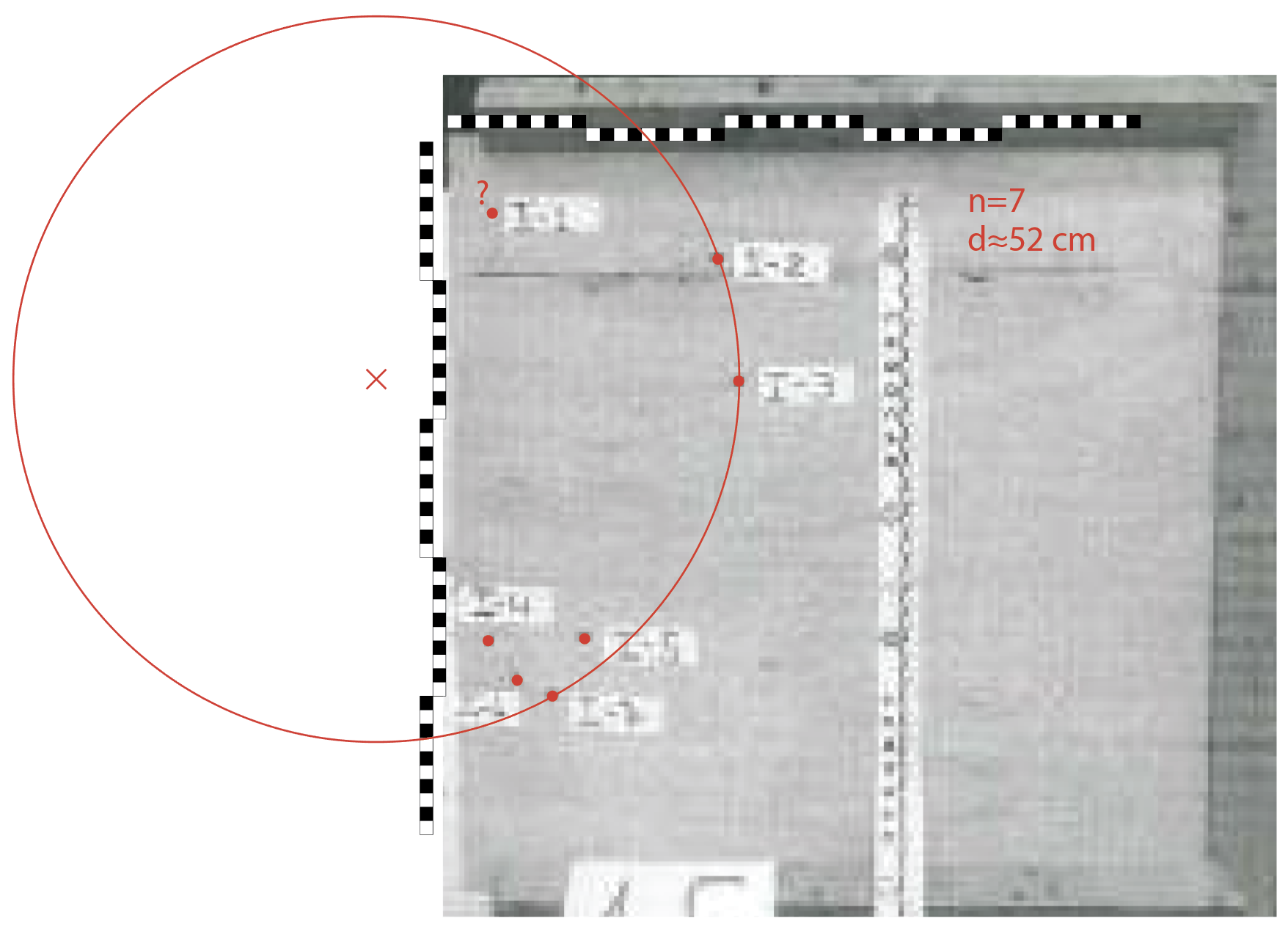
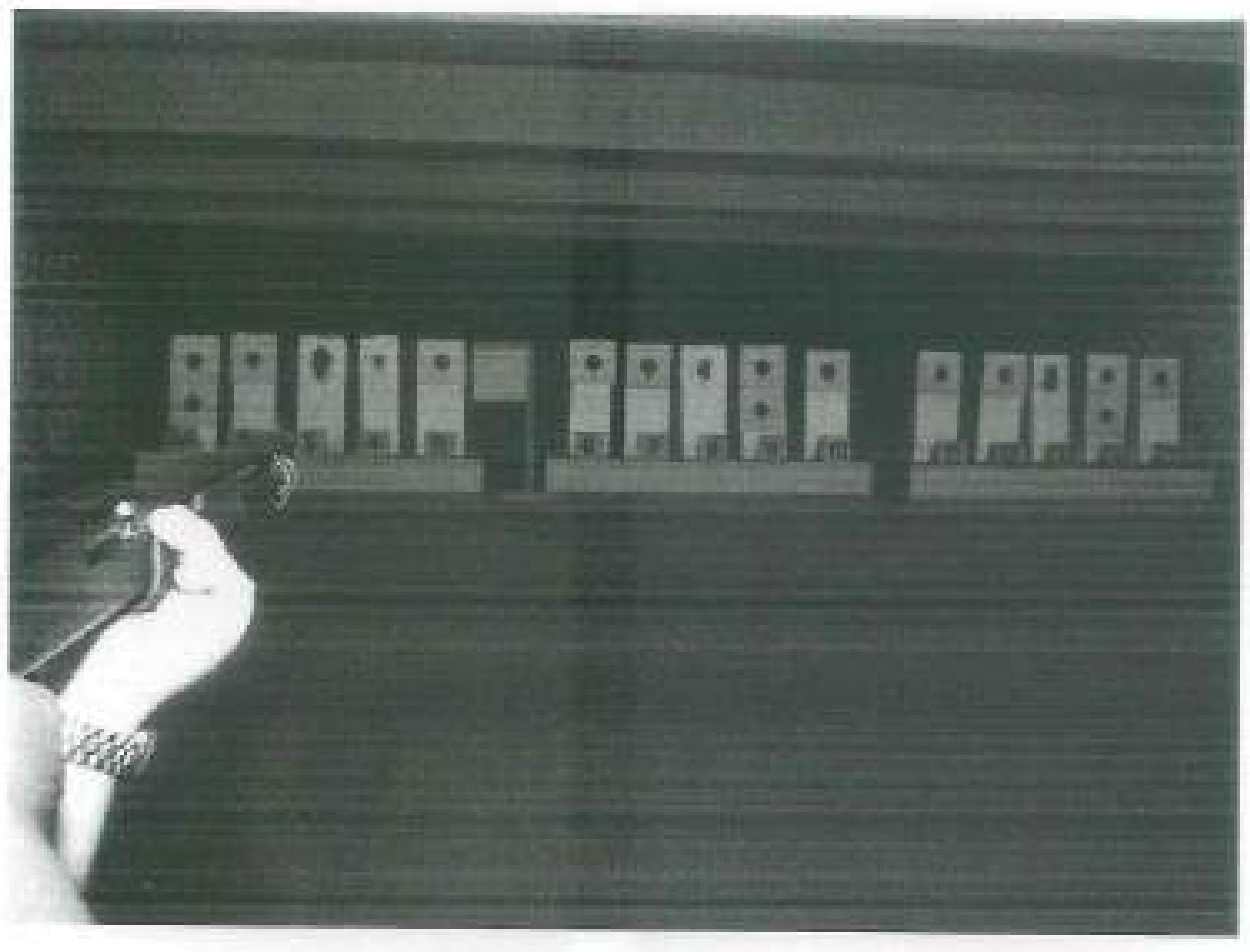
Is this the fault of the gun or the shooter? I suggest the shooter—no tendency is readily apparent looking at the shot patterns, and in any case, it would be an equally serious problem if the Carabineros were fielding firearms that couldn’t shoot accurately at 10 meters. So, while it’s possible that the Carabineros were deliberately aiming at the face, it’s also possible that poor marksmanship—combined with poor selection of ammunition for the engagement distance—could play a significant role in the high number of ocular injuries.
Place yourself in the boots of a young Carabinero: you are in downtown Santiago, vastly outnumbered by enraged protestors yelling all manner of curses at you, some throwing rocks and other projectiles, half-blinded by tear gas, either drugged or totally exhausted—would you then be able to remember the suggested protocol of a 7-year-old report, that may or may not have even been distributed, to accurately hit just the legs of a protestor 30 meters away, with a relatively short (read: less-accurate) shotgun that will disperse its payload over more than a meter?
I emphasize that this isn’t a way of excusing the actions of the Carabineros, as individuals or as an organization. If officers are unable to correctly deploy less-than-lethal weapons in real-life situations, then they shouldn’t be using those firearms at all.
Or more specifically, those munitions. Specialty shotgun rounds such as “beanbag” rounds are still very problematic, and can cause life-threatening injuries, but the great advantage they have is that they are a single projectile—they can be placed far more precisely than dispersed shot. I imagine this is one of the reasons for the complete absence of “rubber shot” in the arsenals of American law enforcement in favor of beanbag rounds—even under ideal circumstances, the risk of misplacing projectiles is too high to warrant the use of less-lethal shot as riot control ammunition. In any case, it is far clearer to identify cases of clear misconduct when single rounds impact the head, and eliminates the dithering that delayed the retirement of rubber shot from the streets.
Beanbag round encountered lodged in the skull of a civilian in Santiago (from the Human Rights Watch report on the police response to unrest in Chile). A ballistic analysis of these rounds is beyond the scope of this post, but at first glance for a beanbag round to penetrate the skull, it would have had to have been fired at near point-blank range, and directly at the face. What I have done here is a numerical exercise that suggests the Carabineros have been shooting at the face; those on the street already know the truth.
Regardless of the question of ill intent, it is clear that the Carabineros are unable to control these rounds so as to avoid causing permanent damage to the targets (and potentially civilians nearby). Although tardy, Director-General Rozas showed commendable foresight in pulling these munitions from the street. I only hope that the Carabineros’ leadership continues to show similar doctrinal flexibility and willingness to compromise in the future.
Appendix: Methods
1 Matlab code available on GitHub here .
2 The dispersion model is a simple Monte Carlo simulation of shotgun pellet dispersion at a specified range and number of shots. It is based on the following principles: that a known percentage of pellets fired from a distance from a cylinder bore shotgun must fall within a 30-inch circle; and that pellet dispersion in the shot pattern is Gaussian. Known values ( Oberfell and Thompson, 1960 ) are used to create a logarithmic curve (r 2 = 0.9983) that describes pellet dispersion with distance. 12 pellet strikes are plotted per shot on polar coordinates, defining rho as a normally-distributed random value with respect to the anticipated dispersion at a specified range, and defining theta as a random value. The process is repeated 5,000 times at 15, 20, 25, 30, 35, and 40 meters. Pellet strikes are scaled to 0.8 cm (diameter of the rubber shot) and eye hits are counted manually as strikes that fall completely or partially within two 4.0 cm x 3.5 cm polygons 29 cm from the center of mass, which approximates the area of the two ocular orbits at a standard distance from the center of mass. “Center of mass” is here defined as the center of the “A zone” in the IPSC standard target .
Key assumptions are Gaussian pellet spread in the shot pattern, aiming for center of mass, and adherence of the “rubber” shot used by the Carabineros to the classic measurements of dispersion for cylindrical barrels. The first assumption is widely adopted in discussions of shotgun pellet spread. The second assumption is based on the a priori statement that there is no evidence of any official directive to shoot for the legs, in which case standard firearms training—which teaches to aim for the center of mass—should revert to the default. The third assumption is tricky due to a lack of a calibrating data set—no official shot patterning data for TEC-brand «perdigones de goma» are publicly available. Although some shot patterns reconstructed from the Carabineros’ internal report of 2012 agree reasonably with the theoretical, the poor quality of the testing precludes further validation (see last section).
Key simplifications are:
- No crosswind effects
- No pellet drop
- No compensation for atmospheric conditions
- No turbulent effects from pellet interference (each pellet is completely independent from the others in this simulation)
- No corrections for different firearms
- Targets facing directly at shooter
- IPSC target represents an average human (no corrections for various body shapes/sizes)
It should be noted that incorporating any one of these factors should increase relative spread, which depending on distance would make it slightly more likely that eye injuries occurred by accident, and slightly less likely that eye injuries were intentional. Overall, by producing “idealized” shot patterns with less interference than that which exists in the real world, the model should slightly underestimate the likelihood that eye injuries were due to spread of shot, and slightly overestimate the likelihood that eye injuries were deliberate.
